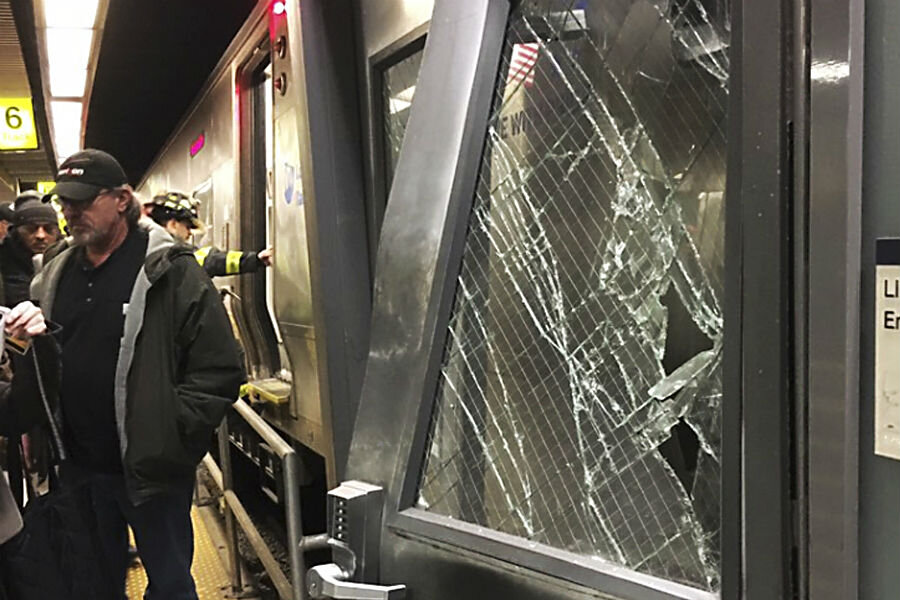What's the key to preventing train crashes?
Loading...
Federal investigators are searching for answers in Wednesday’s Long Island Rail Road (LIRR) commuter train crash. The train failed to stop when entering Brooklyn’s Atlantic Terminal, hitting the “bumper block” at the end of the tracks and injuring more than 100 passengers.
This crash comes as the latest of several recent crashes and derailments on US rail lines. In October, a New Jersey Transit commuter train hit the bumper in Hoboken Station, coming off the tracks and fatally striking a woman on the platform. On May 12, 2015, an Amtrak train derailed after rounding a bend in Philadelphia at high speed, killing eight passengers. In December 2013, a similar crash in the Bronx left four Metro North passengers dead.
These crashes have intensified calls for railroads to adopt a system called Positive Train Control (PTC), which uses GPS data, onboard computers, and other electronics to automatically adjust trains’ speeds based on their locations. Congress has authorized $199 million for railroads to install the technology. But PTC’s limits suggest that safety-minded railroads may also want to improve hiring and training.
“I don’t want people to think that positive train control is a magic bullet that will prevent all accidents,” transportation engineer Gus Ubaldi told CBS New York. Instead, Mr. Ubaldi sees a train’s operator as the key to railroad safety. “Why did he miss his mark?” he asked of the ill-fated LIRR train’s driver.
It’s too soon to tell if this train’s operator caused Wednesday’s crash. But the National Safety Transportation Board (NTSB) attributed two of those other recent crashes to human error. It ruled that Amtrak 188’s engineer had been distracted by radio communications with another train; the driver of the Metro North train that derailed in 2013 apparently suffered from undiagnosed sleep apnea, and nodded off before entering a curve. The federal investigation into last fall's Hoboken crash continues.
The NTSB’s chairman, Christopher Hart, presents PTC as a means to prevent crashes like these. This past May, he said that “the list of PTC-preventable accidents stretches back decades,” pointing to the Bronx and Philadelphia derailments as tragedies that the technology could have averted.
But the challenges – and ongoing delays – of installing sensors, data, and other equipment along America’s vast rail network may require railroads to find other ways to improve safety sooner.
In 2008, Congress mandated the installation of PTC on all rail lines that carry passengers or hazardous material by the end of 2015. In October of that year, with both freight and commuter railroads behind schedule, Congress pushed the deadline back to 2018.
Even as PTC covers more miles of track, gaps in coverage could still pose a danger. Last summer, after an Italian train crash killed 27 people, The Christian Science Monitor reported that the train had been on one of the few sections of Italy’s rail network not covered by automated-braking systems.
Railroads do have another means to minimize the risk of human error: better hiring and safety practices. In its report on the 2013 Metro North crash, the NTSB found that the commuter railroad “did not have an effective system for identifying, monitoring, analyzing, and mitigating safety risks.”
The Board’s investigators found that employees believed that management valued on-time arrival over safety, and feared retribution if they reported safety violations or mistakes. Their report also concluded that Metro North failed to screen and treat employees for sleep apnea, the oversight gap thought to have led to the 2013 crash.
The NTSB recommended that Metro North correct these problems to prevent future crashes. Other commuter railroads may want to take notice. Both New Jersey Transit and the Long Island Rail Road may eventually be covered by PTC. But this system’s slow rollout suggests that lower-tech workplace changes – better safety training, improved hazard reporting, and stronger screening of employees – are currently railroads’ fastest path to keeping passengers safe.
New Jersey Transit has already taken steps in this direction. The NTSB’s final report on its Hoboken crash is still pending, but the Garden State’s railroad has already introduced a new check against drivers’ mistakes. A conductor must now enter the driver’s cab as the train approaches the station, reminding the driver to slow down.







